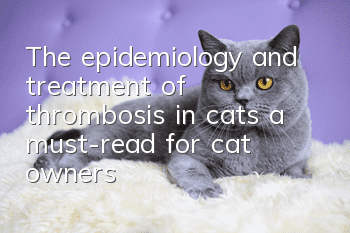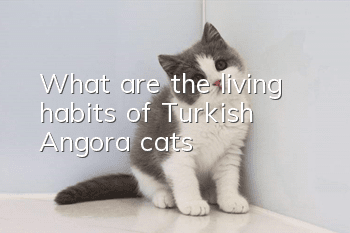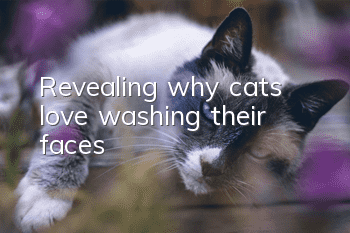The epidemiology and treatment of thrombosis in cats, a must-read for cat owners!

Thrombosis is more common in heart disease
The epidemiology and treatment of feline thrombosis, a must-read for cat owners! The vascular endothelium is damaged. In order to heal, platelets will adhere and agglomerate in the damaged area, causing channels Stenosis, which causes blood obstruction in blood vessels. Damage to blood vessels may be due to chronic causes, such as endocrine and metabolic disorders, sudden severe shock, or some inflammation. Some complications after surgery can also cause thrombosis. , and blood clots often occur in cats with heart disease, which requires attention in daily feeding and medical treatment.
1. Causes
Feline thrombosis is caused by arterial thromboembolism, which usually forms in the left atrium or left ventricle and then migrates with the blood. , emboli in smaller arteries, blocking blood oxygen supply to downstream tissues. More than 90% of embolisms occur in the trifurcation of the aorta, where the artery branches to the two hind legs. The embolized thrombus is saddle-shaped, so it is also called saddle thrombus. In addition, blood clots may also lodge in arteries leading to the forelimbs, brain, gastrointestinal tract, lungs or kidneys, and in the coronary arteries.
Feline thrombosis usually indicates hypertrophic cardiomyopathy. Feline thrombosis can also be secondary to neoplastic disease (usually thoracic and abdominal tumors) and hyperthyroidism. Factors causing thrombosis include local endocardial damage, increased blood viscosity, left atrial dilation, etc.
2. Epidemiology
The incidence rate of feline arterial thromboembolism is 0.6-0.7%, and about two-thirds of affected cats are male cats. , Tianwei male cats have a relatively high incidence of hypertrophic cardiomyopathy. Abyssinian cats are susceptible to heart disease and are susceptible to this disease. Metastasis can occur at any age, but is more common in middle-aged cats. To date, no geographical differences in the disease's distribution have been found.
3. Clinical Symptoms and Diagnosis
Typical clinical symptoms of saddle thrombosis include: quadriplegia of both hind limbs, disappearance of femoral artery pulse in the hind limbs, distal distal limbs The feet and foot pads become cold, and the foot pads and nail beds become cyanotic (blue-purple). 10-12 hours after thrombosis, the tibia and gastrocnemius muscles become stiff due to muscle ischemia, and this stiffness will relieve after 24-72 hours. Cats with acute attacks can withdraw their hind legs by flexing and extending their hips, but they cannot flex or extend their ankles. Symptoms are always more severe on one side than on the other. Most cats will become dehydrated and hypothermic, and may only show intermittent lameness if the embolism is incomplete, but more severe embolisms often develop later.
Affected cats generally present with severe pain (secondary to muscle necrosis caused by insufficient blood flow), asthma (shortness of breath due to pain), decreased body temperature (secondary to shock), and elevated blood sugar ( caused by stress), elevated creatine myosin (secondary to damage caused by poor blood perfusion), azotemia (increased renal indicators, secondary to poor blood perfusion). Auscultation of the heart may reveal a gallop rhythm, a heart murmur, and/or an irregular heartbeat.
UnilateralBrachial artery thrombosis (usually in the right forelimb) can cause monoparesis. Embolism occurring in other parts may cause corresponding symptoms due to ischemia and necrosis of related organs, such as mesenteric artery embolism causing bloody stools, and renal infarction causing azotemia, etc.
Basic diagnosis can be made based on clinical symptoms combined with chest X-rays, ECG, echocardiography, biochemical tests and urinalysis. After thrombosis occurs in cats, creatine phosphokinase increases quickly. The urea nitrogen/creatinine ratio, serum alanine aminotransferase ALT, and aspartate aminotransferase AST increase 12 hours after thrombosis, reaching a peak after 36 hours. Hyperglycemia and hypoemia may occur. Calcium, increased division, rod-shaped leukocytes, and abnormal coagulation. Acute hyperkalemia may occur due to thrombus affecting reperfusion of downstream skeletal muscles. Hypokalemia may occur with loss of appetite and use of diuretics. An echocardiogram can detect blood clots in the heart and blood vessels. Idiopathic echogenicity ("smoke") in the left atrium and left ventricle is associated with flow obstruction and is a precursor to thrombosis. If conditions permit, scintigraphy, magnetic resonance imaging, CT, and angiography can also be used to assist in diagnosis.
4. Treatment
Control concurrent congestive heart failure and severe arrhythmia: including furosemide, oxygen, ACEI, nutritional supplements, etc. .
1. Supportive therapy:
Correct dehydration, adjust acid/alkali/electrolyte balance, keep warm, and nourish. For anorexic cats, a nasogastric tube can be inserted to provide nutrition. The affected cat should also be prevented from excessively licking and biting the distal parts of the necrotic limbs. This kind of self-injurious behavior is relatively common during the recovery period. The use of intravenous catheters in the affected limb where embolism occurs should be avoided.
2. Control pain:
The pain will be severe within 24 hours after the embolism occurs, and then the pain will decrease rapidly. Aspirin (25mg/kg, once every 2 days) is both an analgesic and can inhibit platelet aggregation. Side effects are anorexia and vomiting. Fentanyl pain patches or hydromorphone (0.05-0.1mg/kg) can be used to control moderate to severe pain, and butorphanol (0.2-0.4mg/kg) can be used to control mild to moderate pain. The latter two drugs can be administered subcutaneously, intramuscularly or intravenously, once every 6-8 hours, or every 4 hours if necessary.
No matter which cause causes this disease, it is often accompanied by heart failure and respiratory failure. Therefore, at the first diagnosis, cardiotonic diuresis should be given immediately, and antibiotics should be given for treatment if bacterial endocarditis is caused.
3. Give anticoagulant (500-800 units of heparin/animal, intravenous injection. In the future, additional doses will be added every 3-8 hours according to the coagulation time, subcutaneous injection or intravenous drip injection) and thrombolytic agent ( Urokinase, 3000-6000U/animal, intravenous drip injection). At the same time as medical treatment, thrombus removal surgery should be performed as soon as possible. Since most surgeries are performed under the guidance of angiography, the maintenance of anesthesia should be as shallow as possible (for example, 0.1% microinfusion for cats, 0.0% of the muscle relaxant succinylcholine chloride).2 mg/kg intravenously).
4. For the saddle thrombus at the bifurcation of the external iliac artery, open the abdominal cavity along the midline of the abdomen, carefully peel off the artery, clamp the embolization site front and back with hemostatic forceps, make a small incision at the proximal end, and remove the artery. Thrombus extrusion. Sometimes thrombus will form in the peripheral arteries far away from the heart. The thrombus formed is thin and long, so be careful not to break it when removing it. If necessary, a catheter can be inserted into the artery in the thigh to reach near the thrombus, and then positive pressure can be used to flush out the thrombus. Before blood vessel suturing, heparin and normal saline were injected into the left and right peripheral blood vessels. When suturing, sew the needle holes more closely.
5. After surgery, pay attention to maintaining body temperature, supplementing nutrition, and providing continuous oxygen inhalation.
- Will the cat recognize its owner again?
- Can cats eat fried peanuts?
- Is it normal for a two-month-old kitten to shed tears?
- Are elderly cats susceptible to joint disease? Symptoms of joint disease in pet cats
- How to treat atopic dermatitis in cats How to treat atopic dermatitis in cats
- Why do dogs always lose when cats and dogs fight?
- Why does a cat have eye mucus?
- The cat’s neck lump has not gone away after vaccination
- What to do if your cat wets the bed in revenge
- What should you pay attention to when you first bring a cat home?



